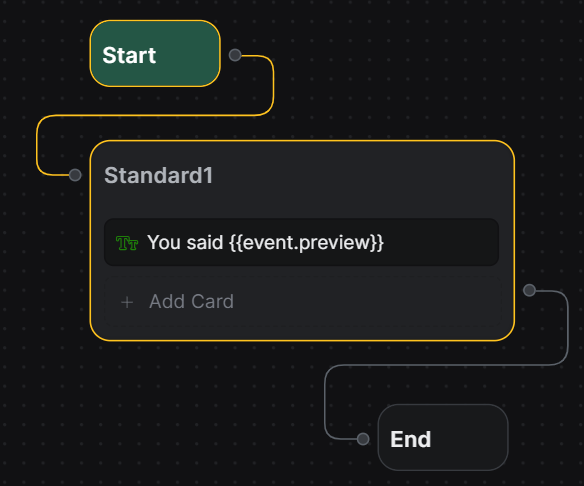- AI chatbots can translate conversations into 100+ languages automatically with an LLM, or you can build custom translation flows for finer control.
- A typical translation setup stores the user’s language, translates incoming messages into the bot’s language, processes them, then translates replies back to the user’s language.
- DeepL is a popular choice for high-quality translations, but any translation API (like Google Translate) can be integrated with similar code.
In today's multilingual world, the ability to interact with users in their native language is a key feature for any chatbot.
If you're building an AI chatbot, translation is automatic if you use an LLM as the 'brain' of your bot. An LLM agent can automatically translate conversations into 100+ languages.
But if you're interested in setting up custom translation capabilities as you build your GPT chatbot, we can help you do it.
In this article, we’ll dive into the specific coding inputs needed to customize your translation.
How does chatbot translation work?
Our strategy revolves around intercepting messages from users, identifying their language, and translating these messages to and from the bot's operating language.
This process entails:
- Storing the detected language
- Translating the user's message to the bot's language
- Processing the message, and then
- Translating the bot's response back to the user's language
For instance, if a user sends a message in Spanish, the bot will store "es" as the language variable. The software will translate the message to English for the bot, and then translate the bot's response back to Spanish before sending it to the user.
Step 1: Pick your tools
Our setup will employ the DeepL Translation service, known for its accuracy and efficiency.
We'll demonstrate this integration with a simple echo bot that responds to users by mirroring their messages. We’ll use Axios for our API calls, since it’s an automatic integration of Botpress.

Step 2: Create the needed variables
Firstly, we need to introduce a user variable named `language` to store the initial or detected language.
DeepL facilitates this process by detecting and returning the language of the input text, simplifying our task to a single API request.
Step 3: Create interception hooks
Before incoming message hook
To intercept and translate the user's message before it reaches Botpress, we introduce a "Before Incoming Message" hook. We will name this hook "Translation-In," which is responsible for translating the incoming message into English and overriding the original message, allowing Botpress to process it as if it were in English.
Here's how the code for this hook looks:
await axios
.post(
'https://api-free.deepl.com/v2/translate',
{
text: [event.preview],
target_lang: 'EN'
},
{
headers: {
Authorization: 'DeepL-Auth-Key {{your key here}}',
'Content-Type': 'application/json'
}
}
)
.then((response) => {
event.payload.text = response.data.translations[0].text
event.preview = response.data.translations[0].text
event.state.user.language = response.data.translations[0].detected_source_language
})
.catch(function (error) {
// Error handling
});IMPORTANT NOTE: Always use Botpress Configuration Variables when incorporating your API Key.
Before outgoing message hook
For the "Before Outgoing Message" hook, we’ll name it "Translation-Out.” It will intercept the bot's response to translate it back into the user's language, ensuring the conversation remains in the user's preferred language.
The implementation involves overriding the outgoing message with its translated counterpart:
await axios
.post(
'https://api-free.deepl.com/v2/translate',
{
text: [outgoingEvent.preview],
target_lang: event.state.user.language
},
{
headers: {
Authorization: 'DeepL-Auth-Key {{your key here}}',
'Content-Type': 'application/json'
}
}
)
.then((response) => {
outgoingEvent.payload.text = response.data.translations[0].text
outgoingEvent.preview = response.data.translations[0].text
})
.catch(function (error) {
// Error handling
});Start Building Today
One of the prominent benefits of using an AI chatbot is its multilingual ability. With platforms like Botpress, you can quickly set up your chatbot to engage with users in over 100 languages.
If you want an accessible and user-friendly chatbot, you can seamlessly integrate any translation service with Botpress. With our channel integrations, you can then deploy your chatbot across WhatsApp, Facebook Messenger, or your website.
Get started today. It’s free.
Further references
FAQs
1. Can I use a translation service other than DeepL, like Google Translate or Microsoft Translator?
Yes, you can use other translation services by modifying the translation hook in Botpress to match the chosen service’s API request and response format. These services can be easily integrated via HTTP calls within custom actions or hooks.
2. Can I selectively translate only parts of a conversation?
Yes, you can selectively translate only parts of a conversation by adding conditional logic in your translation hook that checks for specific message types or user-defined variables before triggering translation. This allows you to control exactly what gets translated and when.
3. Can I anonymize user data before sending it to the translation service?
Yes, you can anonymize user data before sending it to a translation service by preprocessing the message (e.g., using regex to mask names, emails, or IDs) within your Botpress hook or action. This ensures compliance with privacy requirements while still enabling translation.
4. Can I use this translation setup across different channels (e.g., WhatsApp, Messenger)?
Yes, you can use the same translation setup across multiple channels like WhatsApp, Messenger, Slack, or your website. As long as your bot receives the message, the translation logic will function regardless of platform.
5. How do I log translation errors for analytics or debugging?
To log translation errors in Botpress, you can use console.error() for development debugging, or send errors to a custom Botpress table, a remote logging service like Loggly or Datadog, or an internal API. This helps you track failures and monitor performance over time.





.webp)

